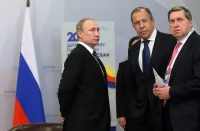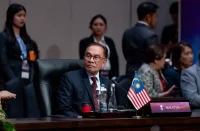Vitaly Bilan (Russia)
His Holiness forged a dialogue between civilizations in the land of the pyramids
In recent years there have been dozens of interfaith clashes in Egypt between the Muslim majority and the Christian (Coptic) minority. That is why the visit by the Patriarch of Moscow and All Rus was so important.
An interfaith hotspot
Cairo has consistently demonstrated its tolerance for members of different faiths living in Egypt. Although Egypt’s official religion under the constitution is Islam, its government is distinctly secular.
Egypt’s media constantly stresses that the country’s Christian population enjoys the same rights as the Muslim majority. In addition, Christmas has been a national holiday since 2003 and thus a non-working day.
However, the government apparently paints a rosy picture about the interfaith environment in Egypt. Religious clashes occur regularly in the country. Still fresh in our memory is the tragic event that occurred in the Egyptian town of Nag Hammadi on the evening of January 6 of this year, the Coptic Christmas eve. Gunmen shot from a passing car into a crowd of worshipers who had attended a holiday mass held in a Coptic Church, killing seven young people and wounding at least nine.
We may soon see a further deterioration in the interfaith environment, mainly due to the country’s socio-economic situation. Egypt’s population grows by 1.2 to 1.3 million annually. About 97% of the population lives in the fertile coastal region of the Nile, i.e., in only 4% Egypt’s land area. Thus, a large number of people is concentrated in an extremely small area. The population is increasing faster than the economy is growing, and that prevents the standard of living from improving.
The country’s high percentage of poverty and overpopulation create conditions in which social tensions are on the rise, and that in turn fosters radicalization in the society.
The interfaith environment in Egypt may also have been exacerbated by the recent death of Muhammed Sayyid Tantawi, head of the most prestigious Sunni Islamic educational institution—the Al-Azhar University. He was considered one of the most prestigious Sunni clerics.
Both the government and the opposition are keenly interested in who becomes head of Al-Azhar University, and for good reason. Founded in 988, Al-Azhar today is Egypt’s main religious Muslim educational institution, and it is also the oldest, largest and most influential Islamic university in the world. Its head is Egypt’s Supreme Imam; he traditionally holds the rank of premier of Egypt and is appointed for life.
Radical Islamists frequently criticized Tantawi for flirting with Coptic Christians. Indeed, Muhammed Sayyid Tantawi and Coptic Patriarch Shenouda III publicly showed understanding and respect for each other. Both often issued statements on critical domestic and foreign policy issues.
At the same time, many members of the Coptic minority were put on guard by the fact that the head of the Egyptian state selected the radical Ahmad al-Tayyib over al-Goma’a, the moderate Grand Mufti of Egypt and head of the department that issues fatwas (religious decrees). Obviously, official Cairo was guided primarily by a desire to seize the PR initiative from the religious opposition.
As a result, the meeting between Patriarch Kirill and the new Sheikh of Al-Azhar was very important and timely. The Primate of the Russian Orthodox Church invited Sheikh Ahmad al-Tayyib to attend the summit of religious leaders in Baku, which is scheduled for April 26-27 of this year. He also proposed establishing a standing joint consultative body that would enable the Russian Orthodox Church and Al-Azhar University to discuss vital issues. The Sheikh accepted Patriarch Kirill’s invitation and promised to attend.
The Patriarch Kirill stressed that the Russian Orthodox Church “had long felt the need for dialogue with the Islamic world at a high theological level.”
He described a joint theological commission with Iran that has been functioning for 10 years. It meets on alternate years in Moscow and Iran to discuss critical issues of current concern to followers of both Orthodox Christianity and Islam.
“We have long wanted to establish similar relations with your university, which is the largest center of Islamic theology,” said Patriarch Kirill.
He also noted that there are excellent examples of the peaceful coexistence of religious majorities and minorities in both the Orient and Russia.
According to the Patriarch, an Orthodox-Muslim dialogue should address what he sees as the dangerous tendency of modern civilization to reject the concept of sin and holiness, good and evil, and the blurring of distinctions between them. In his view, modern Western civilization emphasizes individual liberty by justifying and permitting any behavior that does not violate the freedom of another person. “And that is our shared responsibility—of Christians and Muslims alike who believe in one God and recognize the reality of good and evil, of all who accept that there is such a thing as sin. I think the time has come when believers must stand together,” said the Primate of the Russian Orthodox Church.
Patriarch Kirill obviously made an impression on Sheikh Ahmad al-Tayyib, who has hitherto been regarded as a hardliner. Al-Tayyib said that he is in “complete agreement” with Patriarch Kirill’s characterization of the problems of civilization, humanity, science and education. He noted that “both orthodox Christianity and Islam are distinctly Oriental in nature.”
The Coptic cross
The meeting between Patriarch Kirill and Coptic Patriarch Shenouda III proceeded in a similar vein. The Russian Orthodox Primate specifically focused on the need for the Russian Orthodox and the Coptic Churches to cultivate a theological dialogue and cooperate in advocating Christian moral values in the world. The Patriarch added that this dialogue is not as simple as those who initiated it had assumed.
In the 1970s and 80s, the dialogue between the Russian Orthodox and Coptic churches was quite intense. Now, both sides are trying to make up for lost time.
“The Russian Orthodox Church is very interested now in holding a dialogue with your church. We have a lot of young theologians who have expressed an interest in such a dialogue, including on the issue of Christology. It would be good for young theologians from our countries to meet, share experiences and talk theology,” said Patriarch Kirill.
In responding to journalists’ questions after his meeting with the head of the Coptic Church, the Russian Orthodox Primate said that the world family of local Orthodox churches and the ancient Oriental churches should bear witness about Christian values to the modern world; and they should combine their efforts, especially in the area of ethics and morality.
“In Russia we have high respect for the Coptic Church, which is a martyr-church because belief in Christ has sometimes required special courage of Coptic Christians,” said Patriarch Kirill.
At the conclusion of the dialogue with Shenouda III, Patriarch Kirill gave the head of the Coptic Church a symbol of pontifical ministry and authority—a patriarchal staff—and said, “When you lean on this staff, remember that you have brothers on whom you can also lean.”
Second among equals
The highpoint of the Patriarch’s visit, of course, was the meeting with the Egyptian Orthodox Church.
Official visits by Patriarch Kirill to local Orthodox churches are normally done in accordance with the diptych, the liturgical order of precedence of the Primates of Orthodox churches. The Patriarchate of Alexandria is listed second on the diptych. Patriarch Kirill made the first such visit to the Patriarchate of Constantinople in July 2009.
In contrast to relations with Constantinople, there have never been any problems in relations between the Moscow and the Alexandria Patriarchate.
Both churches have pursued cooperation within the framework of an interfaith dialogue. They have also worked together on preparations for a Synod of all Orthodox churches. During the 1990s Patriarch Theodore of Alexandria was the Alexandrian church’s representative to the Moscow Patriarchal Throne for five years.
Incidentally, Patriarch Kirill had planned to visit Egypt in the fall, but the Patriarch of Alexandria was unfortunately unable to consent for reasons of health.
The Orthodox Church was on the decline during the second half of the first millennium, but now it is bouncing back.
It is considered the fastest growing religion in Africa. There are Orthodox churches in almost every African country. Masses are held in English, Greek, Arabic and native African languages.
Much remains to be done, of course, not least in the Russian Orthodox Church. One interesting idea is the opening of a school of theology and a church at the People’s Friendship University, where most of the students are African, and much more besides.
The visit to Alexandria, the meetings with His Beatitude Theodor II, Patriarch of Alexandria; the prayer service and mass at the Cathedral of the Annunciation; the prayer service in the Church of St. Demetrios of Thessaloniki in Cairo, where the Cairo compound of the Russian Orthodox Church is located; the meeting with Russian nationals living in Egypt; and the visit to Old Cairo where, according to legend, the Holy Family stopped during its flight to Egypt—all combined to show Patriarch Kirill that Orthodoxy cannot be defeated in Egypt.
The Primate of the Russian Orthodox Church has once again demonstrated his ability to find common ground with people of different beliefs.
Source: NEO














Comments